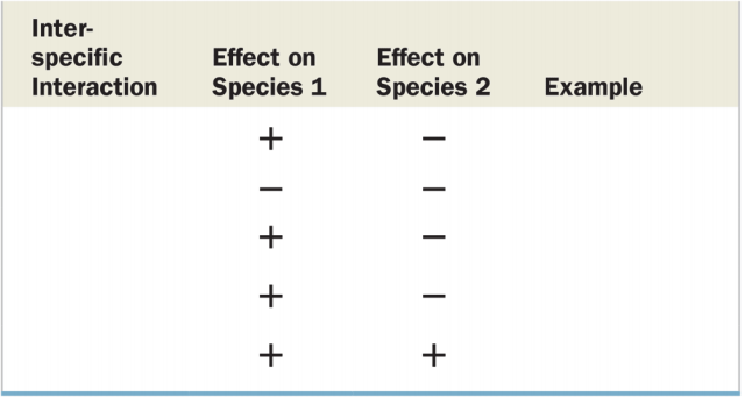
Concept explainers
Fill in the blanks in the table below summarizing the interspecific interactions in a community.

To complete: The blanks summarizing the interspecific interactions in a community.
Introduction: While surviving in an ecosystem, many species interact with each other. These interactions can be mutually beneficial or harmful for one or the other. There are five main types of interspecific interactions, namely, predation, competition, herbivory, parasitism, and mutualism.
Answer to Problem 1CC
Tabular representation: Table 1 represents the interspecific interactions in a community as follows:
| Interspecific interactions | Effect on species 1 | Effect on species 2 | Examples |
| Predation | + | - | Osprey/fish |
| Competition | - | - | Hyenas/vultures |
| Herbivory | + | - | Deer/shrub |
| Parasitism | + | - | Tapeworm/horse |
| Mutualism | + | + | Clown fish/anemone |
Table 1 Depicts the interspecific interactions in a community.
Explanation of Solution
The five types of interspecific interactions are as follows:
Predation: In predative interspecific interactions, one species preys on the other species for food or territory. It is a type of +/- interaction where one species benefits and the other species does not benefit. For example: interaction between a deer and a lion is predation.
Competition: It is the competitive interspecific interaction where two different types of species are competing for the same resource. Neither of them benefits from this, so it is a type of -/- interaction. For example: the interaction between vulture and hyenas.
Herbivory: It is the interaction between the herbivores and the plants. This interaction is a type of +/- interaction where the deer is benefited while the plant is not. For example: an interaction between deer and grass is herbivory.
Parasitism: It is parasitic form of interspecific interaction that involves one organism using the other for food and shelter. One organism such as the tapeworm inhabits the gut or any other part of the other organism such as the horse. This interaction is a +/- interactions, where only one is benefitted.
Mutualism: In this interaction, the organisms that are interacting are mutually beneficial for each other. One species provides one factor, while the other species provides another factor, for example, in the case of mycorrhiza, the fungus is in mutual interaction with the roots of the gymnosperm tree. The fungal element provides minerals and water from the soil, while the tree provides the nutrients. It is a +/+ form of interaction as both the organisms are benefitted.
Want to see more full solutions like this?
Chapter 37 Solutions
CAMPBELL BIOLOGY:CONCEPTS+CONNECTIONS
- Explain in a small summary how: What genetic information can be obtained from a Punnet square? What genetic information cannot be determined from a Punnet square? Why might a Punnet Square be beneficial to understanding genetics/inheritance?arrow_forwardIn a small summary write down:arrow_forwardNot part of a graded assignment, from a past midtermarrow_forward
- Noggin mutation: The mouse, one of the phenotypic consequences of Noggin mutationis mispatterning of the spinal cord, in the posterior region of the mouse embryo, suchthat in the hindlimb region the more ventral fates are lost, and the dorsal Pax3 domain isexpanded. (this experiment is not in the lectures).a. Hypothesis for why: What would be your hypothesis for why the ventral fatesare lost and dorsal fates expanded? Include in your answer the words notochord,BMP, SHH and either (or both of) surface ectoderm or lateral plate mesodermarrow_forwardNot part of a graded assignment, from a past midtermarrow_forwardNot part of a graded assignment, from a past midtermarrow_forward
 Biology Today and Tomorrow without Physiology (Mi...BiologyISBN:9781305117396Author:Cecie Starr, Christine Evers, Lisa StarrPublisher:Cengage Learning
Biology Today and Tomorrow without Physiology (Mi...BiologyISBN:9781305117396Author:Cecie Starr, Christine Evers, Lisa StarrPublisher:Cengage Learning Biology (MindTap Course List)BiologyISBN:9781337392938Author:Eldra Solomon, Charles Martin, Diana W. Martin, Linda R. BergPublisher:Cengage Learning
Biology (MindTap Course List)BiologyISBN:9781337392938Author:Eldra Solomon, Charles Martin, Diana W. Martin, Linda R. BergPublisher:Cengage Learning
 Concepts of BiologyBiologyISBN:9781938168116Author:Samantha Fowler, Rebecca Roush, James WisePublisher:OpenStax College
Concepts of BiologyBiologyISBN:9781938168116Author:Samantha Fowler, Rebecca Roush, James WisePublisher:OpenStax College Human Biology (MindTap Course List)BiologyISBN:9781305112100Author:Cecie Starr, Beverly McMillanPublisher:Cengage Learning
Human Biology (MindTap Course List)BiologyISBN:9781305112100Author:Cecie Starr, Beverly McMillanPublisher:Cengage Learning





